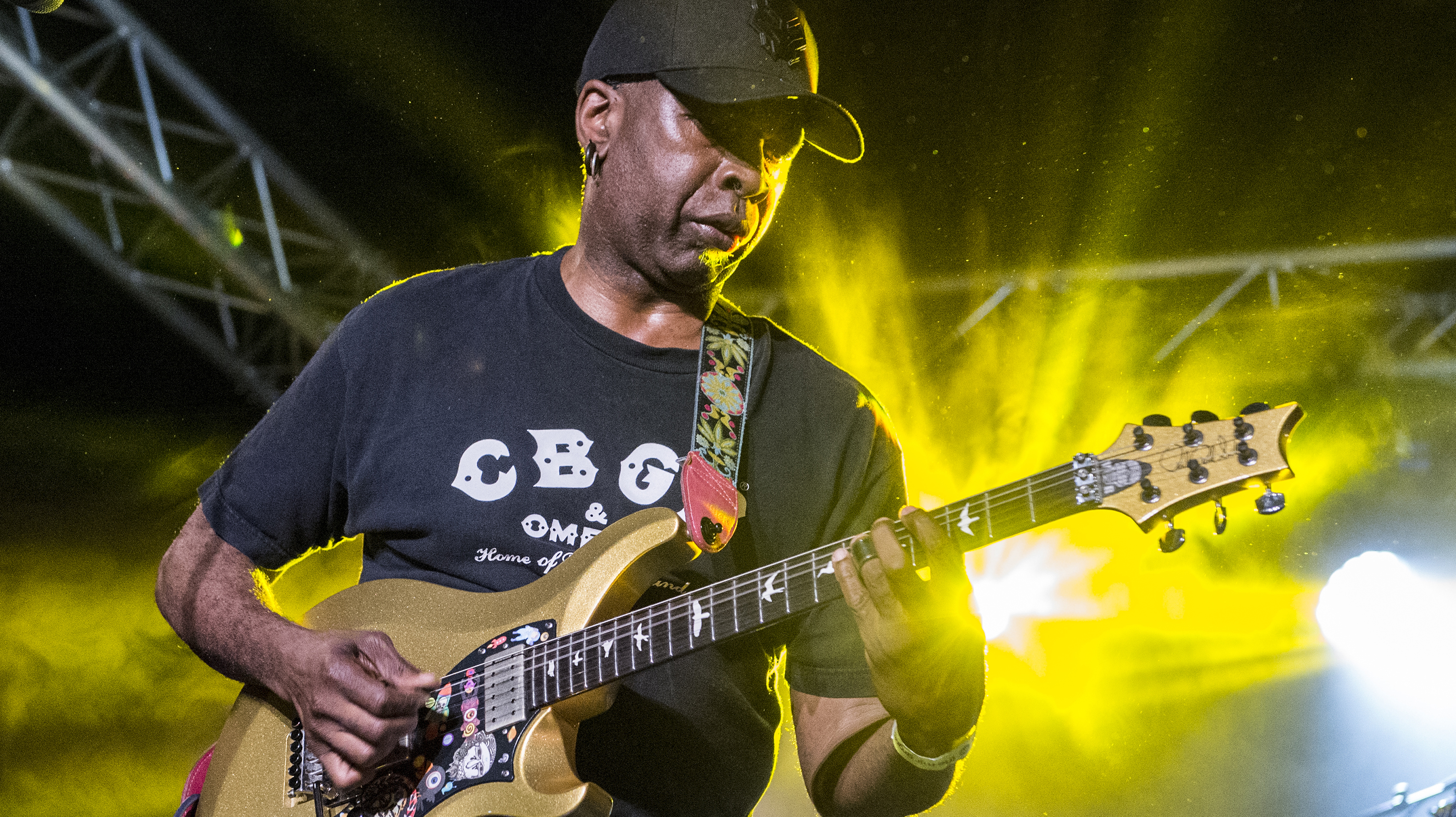“He went through the paperwork, and when he looked at the serial number, the color drained from his face. He just looked ashen.” Vernon Reid reveals how a simple error resulted in his greatest guitar find
The Living Colour guitarist also reveals his favorite and least favorite guitars, and the one that got away

Like most guitar nerds, at his core Vernon Reid is admittedly “managing levels of OCD” as a “gear-obsessed hoarder.” The veteran Living Colour guitarist loves the axes that are near and dear to him as much as the next guitarist, even though he’s most recognized professionally for only a few.
If you’ve been paying attention to Reid’s career, you’ll recall the multicolored ESP shredstick he wielded in Living Colour’s “Cult of Personality” music video back in ’88. Not surprisingly, that guitar, which currently resides in the Smithsonian, means a lot to Reid.
But there’s a cache of electric guitars, ranging from Hamers to Reverends to Tom Andersons, that matter to him almost as much.
And that’s not all, as Reid revealed to Guitar Player when he dialed in to talk about the guitars he loves most, the guitars he can do without, his coolest finds, and the one he let go while in a gear-shedding fugue state.
What’s the one guitar that you can’t live without?
I love all my instruments, you know? I have to pick more than one. The first one is my Hamer Yin-Yang, which Hamer built for me in 1990. It’s a very special instrument for me. It’s the first one in my relationship with Hamer and was designed to take the place of my multicolored ESP, the guitar from the “Cult of Personality” video.
Of course, the guitar from the “Cult of Personality” video is also in that category, but it’s currently at the Smithsonian at the African American History Museum, so I am kind of living without it. And then, I have a custom Tom Anderson. One of my old techs had a relationship with Tom Anderson, and he built me this guitar.

I practice on this guitar all the time, but weirdly enough, I don’t really play it onstage. It’s partly because it’s a Superstrat style, with multi-switches, and I prefer the five-position blade switch because it’s a lot quicker to get to. But I prefer the V-neck configuration, and that Tom Anderson guitar is really just perfect.
Then I have an original prototype from Paul Reed Smith. It’s one of the initial guitars, and because I requested a V-neck profile, Paul personally carved it that way. So that’s very special to me. And moving on to my Reverend guitars, I really am enjoying the Totem. I love the guitars they’re building for me now. So choosing one is hard because I have so much affection for the guitars I have.

Is there a guitar that you don’t enjoy playing?
Early on, I thought the Flying V would be a thing because, well, for obvious narcissistic reasons. [laughs] And because of Albert King. But I found the Flying V to be the most uncomfortable guitar to play. You have to play it standing up — you can’t play it on a knee. And the knee lever thing just seemed crazy, you know?
So the Flying V has never been my thing. I also had a Firebird restored. My middle sister was at a flea market and found this totally discarded, beat-up guitar with three strings. She picked it up for me for about $50 and gave it to me. I took it to Leroy Aiello, who was the head repairman at Mandolin Brothers. [Aiello left the Mandolin Brothers shop, which closed in 2017, to open Aiello Guitars in 2010.] He’s like a forensic scientist with this stuff — one of the greatest repairmen and luthiers in the country.
He restored this Firebird for me. He found a little chip of paint, and he said, “This guitar was originally sparkle green, and he did a new green sparkle thing. So he did that, but I found that I didn’t like it. [laughs] So I sold it to Mandolin Brothers.
"I thought the Flying V would be a thing because, well, for obvious narcissistic reasons. [laughs] And because of Albert King."
— Vernon Reid
So Firebirds, Explorers, and Flying Vs. are cool-looking guitars; I just never bonded with them. And the Flying V was kind of disappointing not to connect with because they’re cool-looking. But again, I just couldn’t bond with it.
What’s one pedal that is always on your ‘board no matter what?
There’s always an Eventide H9 multi-effects now. I’ve been into the [Line 6] Helix architecture thing, but a single pedal that I love is the H9. I also love the DigiTech FreqOut and the feedback-making kind of pedals.

What’s your coolest guitar find?
Living Colour were in L.A. at A&M Studios, and we had a day off. I went down to Norm’s Rare Guitars and bought an acoustic, but I also bought a Gibson ES-345, which has a busted Varitone switch; we thought it was a '68. We put the guitars together and made a package deal.
The price wasn’t too bad — it wasn’t crazy. But then the salesman, whose name I forget, went through the paperwork, and it turns out that this 345, which we thought was a ’68, was actually from 1958. He went through the paperwork, and when he looked at the serial number, the color drained from his face. He just looked ashen.
"Norman stepped up, and he said to me, 'The deal was done in good faith, and the deal will stand.' ”
— Vernon Reid
So Norman himself came out. This moment was very interesting because it was really kind of formal, you know? Norman stepped up, and he said to me, “The deal was done in good faith, and the deal will stand.” He said those exact words.
Now, he looked even paler, and I looked at the salesman and said, “Oh, I don’t want…” Norman said, “Oh, don’t worry. He’s fine.” I thought he was going to get in trouble — and he probably was roasted for the rest of that week. But anyway, this guitar was made the year I was born, 1958, and I used that guitar on “Love Rears Its Ugly Head” [from Time's Up, 1990], and it’s in the video.

What’s one guitar that got away?
There’s a couple, but I wish I still had my Byrdland. My Byrdland had the most gorgeous split maple top, and it’s the guitar I play on “Under Cover of Darkness” on Time’s Up. I was in the middle of a divorce with my first wife, and I would go into these almost fugue states. I got into one of those and took it to Mandolin Brothers.
I’ve sold and traded guitars, and honestly, we’re all kind of hoarders of gear, right? If we’re going to be real, we’re all managing levels of OCD and are gear-obsessed hoarders. [laughs] But occasionally, with my zen pretensions, I will go into the things about attachment and holding onto things, you know?
"But then, I came out of the fugue state, and I woke up one day and was like, 'Holy shit, I’ve got to get my guitar back.' "
— Vernon Reid
So I’ve traded guitars, given guitars and sold guitars. Of course, I have my core guitars that I swear you’ll have to take from my cold dead fingers. [laughs] But I was just in a mood, and I took my Byrdland to Mandolin Brothers and said, “What do you think?” They said, “Oh, man, this is lovely. Are you sure?” I said, “Yeah, yeah.” And I wasn’t in a financial crunch, either.
But then I came out of the fugue state. I woke up one day and was like, “Holy shit, I’ve got to get my guitar back.” I literally went over, after about three weeks or a month. I stormed into Mandolin Brothers, and I’m sure they thought I was about to say, “Where’s my money?”
The guy looked at me and said, “I’ve got your check!” And I’m sure he was completely confused when I looked crestfallen. [laughs] So I made money on the deal, but I couldn’t have been more appalled.
Get The Pick Newsletter
All the latest guitar news, interviews, lessons, reviews, deals and more, direct to your inbox!
Andrew Daly is an iced-coffee-addicted, oddball Telecaster-playing, alfredo pasta-loving journalist from Long Island, NY, who, in addition to being a contributing writer for Guitar World, scribes for Rock Candy, Bass Player, Total Guitar, and Classic Rock History. Andrew has interviewed favorites like Ace Frehley, Johnny Marr, Vito Bratta, Bruce Kulick, Joe Perry, Brad Whitford, Rich Robinson, and Paul Stanley, while his all-time favorite (rhythm player), Keith Richards, continues to elude him.
“We’d heard Jimi Hendrix, we'd heard the Who, but now we finally got to see these guys. And watching Jimi Hendrix burn his guitar….” Grace Slick on Hendrix at Monterey, Jefferson Airplane and the Spanish origins of “White Rabbit”
“I’m still playing but I’m covered in blood. Billy’s looking at me like, ‘Yeah! That’s punk rock!'” Steve Stevens on his all-time worst gig with Billy Idol — and the visit to Jimi Hendrix's grave that never happened









